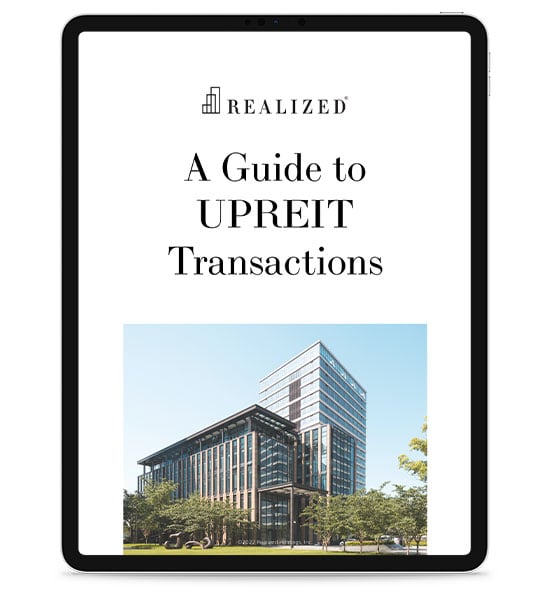
Picture this.
You own income-producing real estate, with a decent cash flow. But you’re tired of the work involved in finding tenants and maintaining property operations. You’d like to sell that property (or properties) and walk away with some profit. But you also know that the sales could trigger capital gains taxes, depreciation recapture costs and other fees.
One potential exit strategy might be through use of an Umbrella Partnership Real Estate Investment Trust structure, also known as an UPREIT. When used properly, an UPREIT can be a helpful tool for your real estate exit strategy.
Defining the UPREIT
As its name suggests, an UPREIT is a partnership. Specifically, it’s a partnership formed between you, the property owner, and a real estate investment trust, or REIT. On your end, you contribute your real estate assets to the partnership. The REIT then provides you with operating partnership (OP) units.
This is known as a 721 UPREIT exchange, which is similar to the 1031 exchange. In other words, you could defer capital gains taxes and depreciation recapture, at least, as long as you hang on to the OP units, and the REIT continues to hold your property.
The Process
Let’s say you own a 200-unit apartment complex, and you’re ready to stop being a landlord. You find a REIT that is interested in the property. You would then:
- Contribute your apartment property to the REIT through a 721 exchange
- You’re issued OP units in the REIT – these are not taxed, as no money actually changes hands
- You can either keep the OP units as is or convert them for shares of REIT stock
Keep in mind that converting those OP shares into REIT stock will trigger capital gains taxes and depreciation recapture. Other tax triggers in this situation include selling your OP units or if the REIT sells your property.
Even with this, an UPREIT strategy can be helpful, as it can with estate planning and overall investment strategies. You could walk away from the hands-on management headaches of direct ownership. You could also benefit by converting your OP units into one or more properties in the REIT’s portfolio. But this procedure will likely trigger a taxable event.
The Caveat
Though UPREITs can provide a helpful real estate exit strategy, there are a few disadvantages. For one thing, there’s no guarantee that the REIT you are interested in even wants your property.
Additionally, once OP units are converted to REIT stock, they’re no longer considered real estate. As such, that stock isn’t eligible for any future 1031 exchanges. There are also tax-filing concerns with OP unit ownership, even without unit conversions. You’re required to file taxes in each state in which the REIT transacts business.
Finally, the 721 exchange might not be an ideal exit strategy. There can be a “lock-up” period during the exchange – and in that time, the market could turn south, meaning the REIT shares might lose value. You also don’t have any voting rights in the REIT (unlike actual REIT shareholders, who do have voting rights).
As such, when considering use of the UPREIT process as an exit strategy, it’s important to proceed with research and due diligence before launching a 721 exchange. Also be sure to consult with a professional who understands how UPREITs function, and who can provide you with guidance before and during the process.
This material is for general information and educational purposes only. Information is based on data gathered from what we believe are reliable sources. It is not guaranteed as to accuracy, does not purport to be complete and is not intended to be used as a primary basis for investment decisions. It should also not be construed as advice meeting the particular investment needs of any investor.
All investments have an inherent level of risk. The value of your investment will fluctuate with the value of the underlying investments. You could receive back less than you initially invested and there is no guarantee that you will receive any income.
Investors who have sold real estate and executed a 1031 Exchange into a DST may execute future 1031 Exchanges and continue to defer taxable gains. Alternatively, a client may enter into a transaction pursuant to IRS Code Section 721 (also known as an UPREIT transaction). In an UPREIT transaction, Clients will receive, at the REIT Sponsor’s option, cash or OP units. OP units are units of an operating partnership that is wholly owned by a REIT. If the client receives OP units, he or she has exchanged into a security and therefore no longer owns real estate and cannot execute another 1031 Exchange out of the OP units and into other real estate. However, pursuant to IRS Code Section 721, the UPREIT transaction into the OP units may qualify as a tax-deferred exchange. The disposition of their interest in OP units will result in a taxable transaction, including the recognition of their deferred capital gain and any depreciation recapture. The client’s gain will only be recognized upon sale or disposition of the OP units.
There is no guarantee that an UPREIT transaction will occur. The option for this transaction is at the discretion of the REIT Sponsor. Some DSTs allow the client to choose whether to take OP Units or cash. Clients should consult the prospectus and their advisor regarding the specifics.
Realized does not provide tax or legal advice. This material is not a substitute for seeking the advice of a qualified professional for your individual situation.



